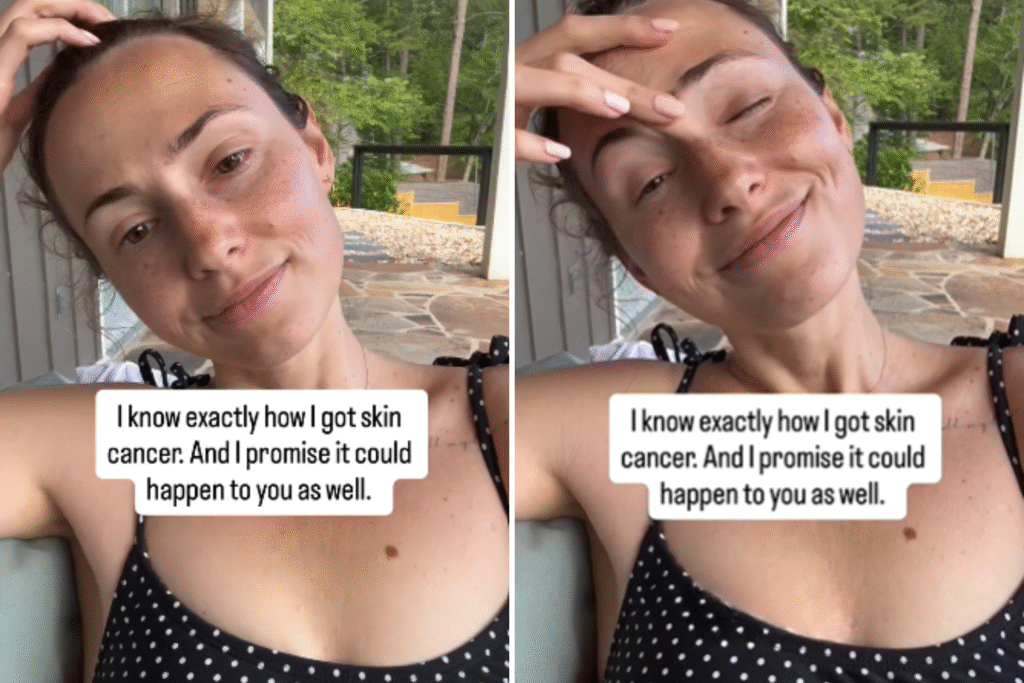“I know exactly how I got skin cancer. And I promise it could happen to you as well.”
That is the warning from 37-year-old April Catudal, who was recently diagnosed with Stage IA melanoma earlier this summer.
The mom who lives in Roswell, Georgia, had never had any issues in previous exams. But, this year, her dermatologist noticed something different.
“I was diagnosed earlier this summer after going in for my yearly skin exam in early June,” Catudal told Newsweek. “My dermatologist immediately saw the mole and biopsied it, though he didn’t expect it to be melanoma since it was an old mole that had grown in size. The biopsy came back as Stage IA melanoma.”
The diagnosis came as a shock—not because of any visible warning signs, but because of what she now realizes was a blind spot in her approach to sun safety.
“The reason I decided to share is because I had been really naive about how important it is to protect my skin,” Catudal said. “I thought I needed to absorb vitamin D, and also I had never had even one annual skin test come back as abnormal, so I had developed a lot of false confidence.”
Catudal said she hadn’t considered herself high risk. She didn’t use tanning beds, never had a bad burn in adulthood, and assumed that brief time in the sun wasn’t dangerous. She also hadn’t been aware of how prevalent skin cancer is, or how serious even early-stage melanoma can be.
“I didn’t know the skin cancer stats in the U.S., and I also wasn’t aware of the emotional and physical toll the diagnosis would have on me, and I truly was as lucky as can be,” Catudal added.
Skin-Cancer Risk Factors
The American Cancer Society’s 2025 Cancer Statistics report an estimated 104,960 new cases of invasive melanoma are expected to be diagnosed in the United States this year, including 60,550 in men and 44,410 in women. Around 8,430 Americans (5,470 men and 2,960 women) are projected to die from the disease.
The American Cancer Society says that exposure to ultraviolet rays is the biggest major risk factor for most melanomas. UV rays damage the DNA inside skin cells, and skin cancers can begin when this damage affects the genes that control skin cell growth.
Around 1 in 10 people with melanoma have a family history of the disease, while there is also evidence that people with lighter skin colors and hair are more at risk.
Catudal said she now believes she knows exactly how she got skin cancer, and it wasn’t from tanning beds or sunbathing. It was gardening.
“I was planting away all spring, removing old pine straw and planting new flower beds, bent with my neck directly exposed to the hot sun for hours at a time,” Catudal said. “Dumb.”
While her dermatologist couldn’t say definitively, he told her it could have been caused by either years of accumulated DNA damage or from a single repeated action, like that intense spring spent outdoors. “To be honest, my dermatologist said there’s no way of knowing if it’s years of accumulated skin DNA damage or way too much exposure from one repeated action (gardening),” Catudal said.
What felt like harmless time in the sun—without sunscreen on just one spot—may have been all it took.
Catudal’s neck, left uncovered during hours in the yard, was where the melanoma appeared. And it is a mistake that many people make without realizing the potential cost.
Catudal had the mole removed and is now cancer-free, but the diagnosis left a lasting impact and prompted her to share her story with others.
“Either way, I’m just so relieved that I had stayed on top of my yearly exam, even though life was crazy,” she said. “And now I’m so very grateful that I get to share my story, help other women in their relative prime stay safe and take care of their skin.”
Read the full article here

